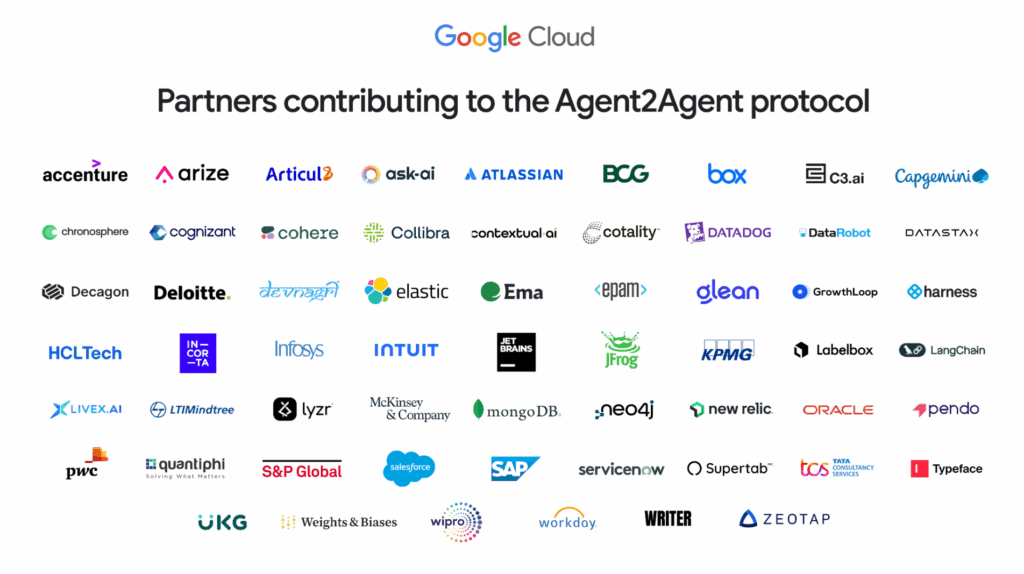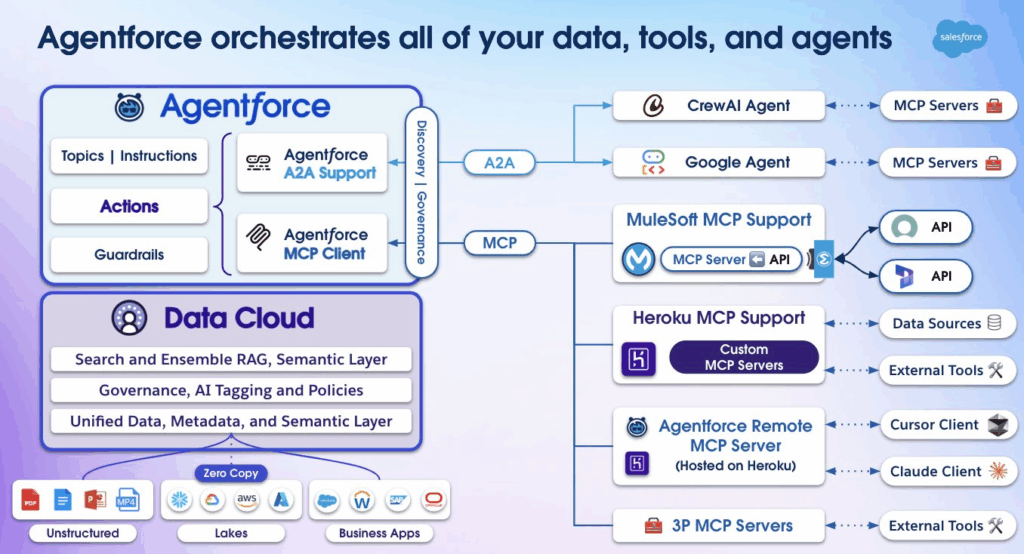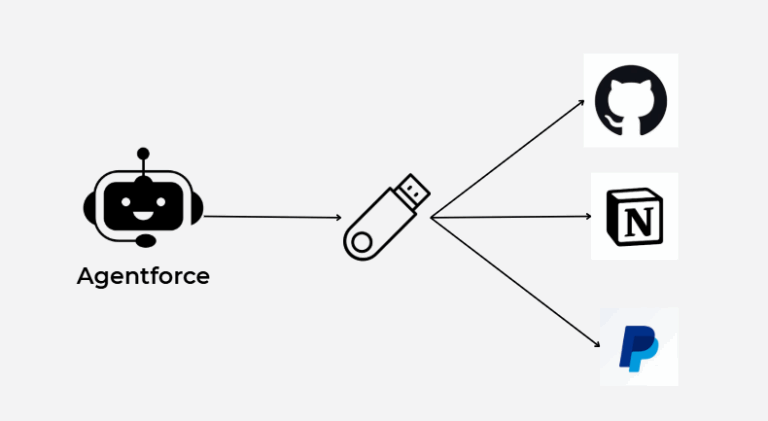From Soloists to an Orchestra
Model Context Protocol (MCP) acts as a universal toolbox, giving individual AI agents standardized access to the tools and data they need to perform tasks. This solved the critical problem of tool integration, turning brilliant but isolated agents into highly capable specialists. But this victory reveals the next great challenge: how do you get a team of these specialized agents—a sales agent from Salesforce, a development agent from Atlassian, and a finance agent from SAP—to work together to solve a complex, multi-domain business problem?
This is the difference between having a group of virtuoso soloists and conducting a symphony orchestra. To create harmony, you need a common language and a shared framework for collaboration. This is precisely the problem that the Agent2Agent (A2A) protocol was designed to solve. It represents the next layer of interoperability, moving beyond agent-tool communication to enable true agent-to-agent collaboration.
A Universal Language for Agents: Understanding the A2A Protocol
Launched in April 2025 by Google in collaboration with Salesforce and over 50 other technology leaders, the Agent2Agent (A2A) protocol is an open standard designed to allow AI agents to communicate, securely exchange information, and coordinate actions, regardless of who built them or what framework they use. This initiative signifies a massive industry consensus on the need for a standardized way to create multi-agent ecosystems.

A broad coalition of over 50 technology and service partners are contributing to the Agent2Agent protocol, signaling a unified industry push for AI interoperability. Image from Surapaneni, R., Jha, M., Vakoc, M., & Segal, T. (2025, April 9). ‘Announcing the Agent2Agent Protocol (A2A)’. Google Developers Blog. Accessed from https://developers.googleblog.com/en/a2a-a-new-era-of-agent-interoperability/.
A2A is built on a set of clear design principles aimed at enterprise readiness and developer accessibility:
- Built on Existing Standards: It leverages familiar technologies like HTTP, JSON-RPC, and Server-Sent Events (SSE), making it easier to integrate into existing IT stacks.
- Secure by Default: A2A is designed from the ground up with enterprise-grade authentication and authorization, supporting established patterns like OpenAPI’s authentication schemes.
- Supports Long-Running Tasks: The protocol is flexible enough to handle everything from quick, single-shot requests to complex research tasks that might take hours or even days to complete, providing status updates along the way.
- Modality Agnostic: Recognizing that agentic interaction is not limited to text, A2A is designed to support various modalities, including audio and video streaming.
The mechanics of A2A are elegant and powerful, centered around a few key concepts:
- Capability Discovery: How do agents find each other? Through an “Agent Card.” This is a simple JSON file that acts as an agent’s business card, advertising its identity, capabilities, and security requirements. A client agent can use these cards to discover the right specialist agent for a given job.
- Task Management: Communication is oriented around a “Task” object. When one agent asks another to do something, it creates a task. This task has a defined lifecycle (e.g.,
submitted,working,completed,failed), allowing the requesting agent to track progress and manage the workflow. - Collaboration and Output: Agents collaborate by exchanging messages containing context, user instructions, or replies. The final output of a completed task is delivered as an “Artifact,” a structured result that ensures the output is consistent and usable.
MCP vs. A2A: Two Sides of the Same Interoperability Coin
It is crucial to understand that MCP and A2A are not competing standards; they are complementary protocols designed to solve different parts of the interoperability puzzle. Confusing them is easy, but a clear analogy makes their distinct roles obvious:
If an AI agent is a skilled professional, then MCP is its personal toolbox. It gives the agent access to the specific wrenches, screwdrivers, and diagnostic equipment (APIs, databases, files) it needs to do its job.
A2A is the universal language and project management framework that allows this professional to collaborate with other specialists on a large project. It’s how the mechanic talks to the parts supplier and the electrician.
The most important technical distinction lies in what is being connected.
- MCP connects an agent to a structured tool. A tool is a predictable function with a defined input and output, like
get_weather(location). The tool itself has no intelligence or goals. - A2A connects an agent to another opaque agent. An agent is an autonomous system with its own goals, reasoning capabilities, and its own private set of tools (which it likely accesses via MCP). When one agent delegates a task to another via A2A, it doesn’t know or care how the second agent accomplishes it; the internal logic is a “black box”.
This enables the creation of powerful, hierarchical “agent-of-agents” systems, where a primary orchestrator can manage a team of specialists to automate incredibly complex workflows.

Salesforce’s complete vision: Data Cloud provides the foundation, while Agentforce acts as the central orchestrator, using A2A to collaborate with other agents and MCP to connect with a universe of tools via MuleSoft, Heroku, or the AgentExchange. Image Source: Sharaf, S., Lerhaupt, G., et al. (2025, April 28). ‘When Agents Speak the Same Language: The Rise of Agentic Interoperability’. Accessed from https://www.salesforce.com/blog/agent-interoperability/?utm_campaign=amer_cbaw&utm_content=Salesforce__sprout-1746221094&utm_medium=organic_social&utm_source=linkedin
Salesforce’s Strategic Bet on an Open, Collaborative Future
Salesforce’s deep commitment to open standards like MCP and A2A might seem counterintuitive for a company historically known for its powerful, self-contained ecosystem. However, it represents a shrewd and forward-looking strategic bet. Salesforce recognizes that it cannot—and should not—try to build the single best AI agent for every conceivable business function. Deep domain expertise lies with other leaders: Atlassian for development, Workday for HR, SAP for ERP.
Attempting to compete with every specialist in a closed system is a losing battle. The winning strategy is to become the central, trusted orchestration hub where all of these disparate, best-in-class agents can come to collaborate securely. By leading with support for open standards, Salesforce positions Agentforce as the “Switzerland” of enterprise AI—the neutral, secure, and governed platform where a customer can manage their entire digital workforce, regardless of where the individual agents were built [A2A Announcement]. This strategy transforms Agentforce from a product that competes with other agents into a platform that multiplies the value of all of them, vastly increasing its strategic importance and market potential.
Conclusion: Are We Entering the Era of True AI Collaboration?
MCP provides the universal toolbox, giving agents the power to act. A2A provides the universal language, giving them the power to collaborate. Together, they enable a future of composable enterprise automation, where complex problems are solved not by monolithic applications, but by dynamic, orchestrated assemblies of intelligent agents. The silos are breaking down, the languages are converging, and the orchestra is beginning to tune its instruments.
Are we entering the era of true AI collaboration? The evidence suggests we are standing right at its dawn.
References:
A2A Project. (n.d.-a). A2A protocol. Retrieved July 9, 2025, from https://a2aprotocol.ai/
A2A Project. (n.d.-b). A2A: An open protocol enabling communication and interoperability between opaque agentic applications [Source code repository]. GitHub. Retrieved July 9, 2025, from https://github.com/a2aproject/A2A
A2A Project. (n.d.-c). Development guide. Retrieved July 9, 2025, from https://a2aprotocol.ai/docs/guide/a2a-typescript-guide.html
Surapaneni, R., Jha, M., Vakoc, M., & Segal, T. (2025, April 9). Announcing the Agent2Agent Protocol (A2A). Google Developers Blog. https://developers.googleblog.com/en/a2a-a-new-era-of-agent-interoperability/



